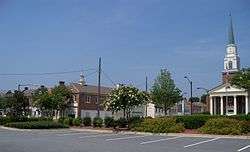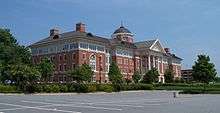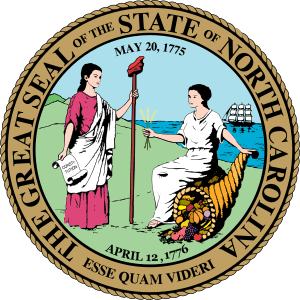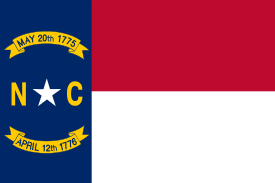Kannapolis, North Carolina
Kannapolis (Kŭh-nă-pŭh-lŭs) is a city in Cabarrus and Rowan counties, in the U.S. state of North Carolina,[1][2] northwest of Concord and northeast of Charlotte and is a suburb[8] in the Charlotte metropolitan area. The city of Kannapolis was incorporated in 1984. The population was 42,625 at the 2010 census,[9] which makes Kannapolis the 20th largest city in North Carolina. It is the home of the Kannapolis Cannon Ballers, the Class A baseball affiliate of the Chicago White Sox, and it is the hometown of the Earnhardt racing family. The center of the city is home to the North Carolina Research Campus, a public-private venture that focuses on food, nutrition, and biotech research.
Kannapolis, North Carolina | |
|---|---|
 Kannapolis Downtown | |
Location of Kannapolis, North Carolina | |
| Coordinates: 35°30′1″N 80°37′27″W | |
| Country | |
| State | North Carolina |
| Counties | Cabarrus and Rowan[1][2] |
| Founded | 1906 |
| Incorporated | 1984 |
| Government | |
| • Type | Council - Manager |
| • Mayor | Milton Darrell Hinnant |
| Area | |
| • Total | 33.28 sq mi (86.19 km2) |
| • Land | 32.71 sq mi (84.73 km2) |
| • Water | 0.56 sq mi (1.46 km2) |
| Elevation | 780 ft (237.74 m) |
| Population (2010) | |
| • Total | 42,625 |
| • Estimate (2019)[4] | 50,841 |
| • Density | 1,554.11/sq mi (600.04/km2) |
| Time zone | UTC-5 (EST) |
| • Summer (DST) | UTC-4 (EDT) |
| ZIP codes | 28081, 28082, 28083 |
| Area codes | 704, 980 |
| FIPS code | 37-35200[5] |
| GNIS feature ID | 1021013[6] |
| Website | kannapolisnc |

History
Name
Early meaning and usage of the city's name was a direct reference to Cannon Mills Corporation, or James William Cannon himself. Early published name variations include "Cannon-opolis" and "Cannapolis". A widely accepted origin of the word "Kannapolis" comes from the combination of the Greek words kanna (reeds, not looms) and polis (city), which some believed meant "City of Looms".[10] Dr. Gary Freeze, Catawba College history and politics department chairman, said a Concord newspaper used the name "Cannon City" in 1906. After mill workers or newspapers called the town "Cannapolis", J.W. Cannon asked Cabarrus County commissioners to give the town the name, but starting with a "K". Kannapolis historian Norris Dearmon said the K might have been to distinguish the town from his Concord mill village. Since, Freeze said, "Jim Cannon didn't study Greek," Cannon did not name the town "city of looms".[11] In 1906 J.W. Cannon purchased the land that later became Kannapolis, and acquired a total of 1,008 acres in Cabarrus and Rowan Counties. Approximately 808 of those acres of farmland, purchased along the historic wagon road between Salisbury and Charlotte, became the location of the new textile mill, Cannon Manufacturing. Cannon Manufacturing began production in 1908. In 1914 Cannon Manufacturing became known as the world's largest producer of sheets and towels. Shortly after, Mr. Cannon opened plants in Rowan County, Concord and in South Carolina totaling 20,000 workers. Mill founder J.W. Cannon's youngest son, Charles A. Cannon, consolidated all the separate mills into the giant Cannon Mills Company in 1928.
National Register of Historic Places
The Meek House and Harvey Jeremiah Peeler House are listed on the National Register of Historic Places.[12]
Geography
Kannapolis is located on the boundary of Cabarrus and Rowan counties, with a greater portion of its area in Cabarrus County. U.S. Route 29 (Cannon Boulevard) passes through the city east of the downtown area; U.S. 29 leads northeast 15 miles (24 km) to Salisbury and south 7 miles (11 km) to Concord. Interstate 85 bypasses the city on the south and the east, with access from Exits 54 through 63 (five exits total). I-85 leads northeast 65 miles (105 km) to Greensboro and southwest 21 miles (34 km) to Charlotte.
According to the United States Census Bureau, the city has a total area of 32.5 square miles (84.2 km2), of which 31.9 square miles (82.7 km2) is land and 0.58 square miles (1.5 km2), or 1.73%, is water.[9]
Education
K-12
Kannapolis City Schools is the primary school system for the city. Two additional systems also serve its jurisdiction: Cabarrus County Schools and Rowan–Salisbury School System.
Faith Christian Academy (FCA) is a private, non-profit Christian educational institution that is operated by Faith Baptist Church. Faith Christian Academy offers a combination of the A Beka program (K5 - 2ᴺᴰ grade) and the Alpha-Omega computerized, individual learning program (3ᴿᴰ - 12ᵀᴴ grade). FCA was organized in 1982.
Franklin Heights Christian Academy (FHCA) is a private, non-profit Christian educational institution that is operated by Franklin Heights Baptist Church. FHCA was organized in 2009. This school is now closed.
Higher education
Shaw University has an extramural site in Kannapolis offering undergraduate, graduate and continuing educational programs.
Ambassador Christian College has a campus in Kannapolis offering undergraduate and graduate degrees in Theology. The school was founded in 2003 by Dr. Keith Slough.
North Carolina Research Campus

The North Carolina Research Campus in Kannapolis is a 350-acre (140 ha) research center. Corporations, universities and healthcare organizations have forged a public-private partnership at the intersection of human health, nutrition and agriculture by focusing on food and nutrition and biotech research. The partners include Appalachian State University, the David H. Murdock Research Institute, Dole Nutrition Research Laboratory, Duke University MURDOCK Study, General Mills, JC Med, Monsanto, NC A&T University, NC Central University, NC State University, UNC-Chapel Hill, UNC Charlotte, and UNC Greensboro.
David H. Murdock, owner of the real estate company Castle & Cooke and former CEO of Dole Food Company, and Molly Corbett Broad, president of the 16-campus University of North Carolina system, unveiled plans on September 12, 2005, for the research campus, as an economic revitalization project that encompasses the site of the former Cannon Mills plant and entire downtown area of Kannapolis.
During the next few years, the NC Research Campus was developed by Castle and Cooke in collaboration with UNC General Administration and several North Carolina universities, including NC State, UNC-Chapel Hill, and others. In 2008, faculty from NC State, UNC-Chapel Hill, UNC Charlotte, UNC Greensboro, NC A&T, NC Central, and Appalachian State moved into the Nutrition Research Institute building, operated by UNC-Chapel Hill, and the Plants for Human Health Institute, operated by NC State. The buildings are owned by Castle and Cooke, which rents the space to the UNC system in a rent-to-own agreement.
Funding for research and education activities at NCRC comes from federal and private research grants and donations, which support individual laboratories, and from the North Carolina State budget, which supplies general operating expenses and salaries for faculty and support staff. Funding from the Legislature is disbursed to individual universities to support their operations at NCRC.
The David H. Murdock Research Institute, a not-for-profit research institute, operates a Core Lab facility that offers genomic sequencing, metabolomics profiling, and other research services.
Demographics
| Historical population | |||
|---|---|---|---|
| Census | Pop. | %± | |
| 1990 | 29,696 | — | |
| 2000 | 36,910 | 24.3% | |
| 2010 | 42,625 | 15.5% | |
| Est. 2019 | 50,841 | [4] | 19.3% |
| U.S. Decennial Census[13] | |||
As of the census[5] of 2000, there were 36,910 people, 14,804 households, and 10,140 families residing in the city. The population density was 1,236.5 people per square mile (477.4/km2). There were 15,941 housing units at an average density of 534.0 per square mile (206.2/km2). The racial makeup of the city was: 77.74% White, 16.45% Black or African American, 6.33% Hispanic or Latino American, 0.86% Asian American, 0.34% Native American, 0.01% Native Hawaiian or Other Pacific Islander, 3.43% some other race, and 1.16% two or more races.
There were 14,804 households, out of which 30.0% had children under the age of 18 living with them, 50.4% were married couples living together, 13.5% had a female householder with no husband present, and 31.5% were non-families. 26.5% of all households were made up of individuals, and 11.4% had someone living alone who was 65 years of age or older. The average household size was 2.46 and the average family size was 2.96.
In the city, the population was spread out, with 24.2% under the age of 18, 9.0% from 18 to 24, 30.4% from 25 to 44, 20.8% from 45 to 64, and 15.6% who were 65 years of age or older. The median age was 36 years. For every 100 females, there were 93.7 males. For every 100 females age 18 and over, there were 90.0 males.
The median income for a household in the city was $35,532, and the median income for a family was $42,445. Males had a median income of $30,990 versus $23,277 for females. The per capita income for the city was $17,539. About 7.7% of families and 10.5% of the population were below the poverty line, including 14.6% of those under age 18 and 10.7% of those age 65 or over.
Parks and recreation
Public
Kannapolis has several public recreational areas. These include parks, athletic fields and greenways. One public park in the city, Vietnam Veterans Park (formerly, North Cabarrus Park) is maintained and operated by Cabarrus County.[14]
- Bakers Creek Park
- Dale Earnhardt Plaza
- Veterans Park
- Vietnam Veterans Park (formerly, North Cabarrus Park)
- Village Park
- Walter M. Safrit Park
Sports
- Kannapolis Cannon Ballers, Class "A" Baseball Affiliate of the Chicago White Sox
- Stewart-Haas Racing, a NASCAR Cup Series team established by Gene Haas
- Haas F1 Team, a Formula One team, also established by Gene Haas
Transportation
Kannapolis is located adjacent to Interstate 85, approximately 20 miles (32 km) northeast of Charlotte.
Concord Kannapolis Area Transit, also known as Rider, provides multiple local bus routes, with its farthest point reaching Concord Mills Mall.
Charlotte Area Transit System (CATS) provides multiple transportation options including bus, vanpool or carpool. CATS provides a bus stop and parking at Kannapolis' Home Depot parking lot.
The Kannapolis Amtrak station is located at 201 South Main Street.[17]
Film
In 2004, a silent film about Kannapolis, showing the everyday behavior of ordinary people, which was made in 1941 by itinerant filmmaker H. Lee Waters, was selected by the Library of Congress for listing in the United States National Film Registry, as a representative of this kind of filmed "town portrait" popular in the 1930s and 1940s.[18]
Notable people
- Tavis Bailey, American discus thrower at the 2016 Summer Olympics
- George Clinton, leader of Parliament-Funkadelic
- Dale Earnhardt, former NASCAR champion
- Dale Earnhardt Jr., former NASCAR driver
- Kerry Earnhardt, former NASCAR driver
- Ralph Earnhardt, former NASCAR driver
- Carl Ford, Republican member of the North Carolina Senate[19]
- Daniel Hemric, current NASCAR driver
- Ethan Horton, former football player
- Kameron Marlowe, country music singer-songwriter
- Melissa Morrison-Howard, American hurdler best known for winning two Olympic bronze medals[20]
- Glenn McDuffie, retired World War II sailor, picture subject of V-J Day in Times Square
- James McDuffie, North Carolina Senator
- Mike Morton, NFL linebacker and Super Bowl XXXIV champion with the St. Louis Rams[21]
- Brandon Parker, NFL offensive tackle[22]
- Elizabeth Safrit, journalist, Miss World America 2014
- George Shinn, former owner of the Charlotte Hornets
- Dixie Upright, former MLB player
- Garrett Gentry, former lead singer of Honeywagon and drummer of Stronghold Crvsader. Once chased green label Jack Daniels with fruit punch and puked in a sheet rock bucket.
References
- "Subcounty population estimates: North Carolina 2000-2006". United States Census Bureau, Population Division. 2007-06-28. Archived from the original (CSV) on 2008-09-29. Retrieved 2008-05-28.
- "NC State Law 2009-430". NC State Laws. Retrieved 30 August 2011.
- "2019 U.S. Gazetteer Files". United States Census Bureau. Retrieved July 27, 2020.
- "Population and Housing Unit Estimates". United States Census Bureau. May 24, 2020. Retrieved May 27, 2020.
- "U.S. Census website". United States Census Bureau. Retrieved 2008-01-31.
- "US Board on Geographic Names". United States Geological Survey. 2007-10-25. Retrieved 2008-01-31.
- Jenkins, Scott (2001-07-20). "Kannapolis City Council will consider adopting logo". Salisbury Post. Archived from the original on 2006-10-19. Retrieved 2006-05-12.
- "Search for Public Schools - School Detail for A L Brown High". ed.gov. Retrieved 9 August 2015.
- "Geographic Identifiers: 2010 Demographic Profile Data (G001): Kannapolis city, North Carolina". U.S. Census Bureau, American Factfinder. Archived from the original on February 12, 2020. Retrieved December 18, 2014.
- Dearmon, Norris (2006-07-20). "Name Origin File". History Room at the Kannapolis Branch of the Cannon Memorial Library. Retrieved 2007-11-12.
- Ford, Emily (2009-12-11). "Kannapolis might not be city of looms". Salisbury Post. Archived from the original on 2009-12-15. Retrieved 2009-12-12.
- "National Register Information System". National Register of Historic Places. National Park Service. July 9, 2010.
- "Census of Population and Housing". Census.gov. Retrieved June 4, 2015.
- "Overview of Parks Facilities". City of Kannapolis. Retrieved August 30, 2015.
- "The Club". The Club at Irish Creek. Retrieved July 9, 2012.
- "Kannapolis Recreation Park". Kannapolis Recreation Park. Retrieved July 9, 2012.
- "Kannapolis, NC (KAN)". Amtrak. Retrieved July 9, 2012.
- Library of Congress "Librarian of Congress Adds 25 Films to National Film Registry" News from the Library of Congress (28 December 2004)
- Carl Ford's Biography. justfacts.votesmart.org. Retrieved Feb 13, 2020.
- Plemmons, Mark. (Oct 23, 2013). Cabarrus Hall induction set for Thursday. Independent Tribune. Retrieved Feb 13, 2020.
- NFL Alumnus Mike Morton: Dentist, Game Official and Father of Quadruplets Archived 2020-02-13 at the Wayback Machine. nflalumni.org. Retrieved Feb 13, 2020.
- NFL Draft & Combine Profile - Brandon Parker. nfl.com. Retrieved Feb 13, 2020.
Further reading
- Minchin, Timothy J., "'It Knocked This City to Its Knees': The Closure of Pillowtex Mills in Kannapolis, North Carolina, and the Decline of the U.S. Textile Industry," Labor History 50 (Aug. 2009), 287–311
- Vanderburg, Timothy W. Cannon Mills and Kannapolis: Persistent Paternalism in a Textile Town (University of Tennessee Press; 2013) 255 pages
External links
| Wikivoyage has a travel guide for Kannapolis. |
- City of Kannapolis official website
- The Salisbury Post, daily newspaper serving Kannapolis, with archives of the former Kannapolis Citizen weekly
- Kannapolis City Schools
- North Carolina Research Campus
- Kannapolis Macaroni Kid - Family Friendly Events Calendar
- Guide to the Kannapolis Oral Histories 2008
- Guide to the City of Kannapolis reports and magazines 2006-2011
- Guide to the Kannapolis News Clippings 2006-2008


